An interview with Laila Bahaa-el-din, a part of our on-going Interviews with Young Scientists series.
.568.jpg)
African golden cat in Precious Woods Gabon logging concession. Photo by: Laila Bahaa-el-din/Panthera.
Africa is known as the continent of big cats: cheetahs, leopards, and of course, the king of them all, lions. Even servals and caracals are relatively well-known by the public. Still, few people realize that Africa is home to a number of smaller wild cat species, such as the black-footed cat and the African wild cat. But the least known feline on the continent is actually a cryptic predator that inhabits the rainforest of the Congo and West Africa.
“The African golden cat has dominated my thoughts and energy for over a year and a half now. When carrying out a study like this one, you find yourself trying to think like your study animal,” Laila Bahaa-el-din, University of Kwazulu Natal graduate student, told mongabay.com in a recent interview.
Thinking like a wild forest cat has helped Bahaa-el-din capture the world’s first publicly released footage of the African golden cat (Profelis aurata) in its rainforest home in Gabon. Using camera traps—automated digital cameras that take a flash photo whenever an animal triggers an infrared sensor—Bahaa-el-din was able to catch a male golden cat resting directly in front of the camera as well as playfully chasing a bat (videos at the end of the interview). The videos and photos captured by Bahaa-el-din have already proven the cat is likely not nocturnal as long-assumed, but is in fact active both during day and night. Still, much more needs to be discovered.
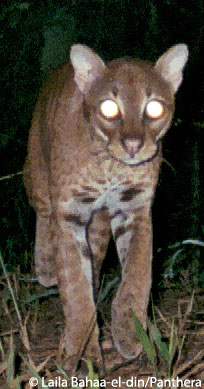 African golden cat in Precious Woods Gabon logging concession. Photo by: Laila Bahaa-el-din/Panthera. |
“The population densities at which they live, the size of their home ranges, and their activity patterns all remain to be established,” Bahaa-el-din says. Without this information, it is impossible to set up a conservation plan—the ultimate goal of Bahaa-el-din’s work supported by the University of Oxford’s Wildlife Research Unit and cat conservation organization, Panthera.
Currently, Bahaa-el-din is using camera traps to compare African golden cat populations in various habitats: a pristine forests, a well-managed logging concession and a poorly-managed one.
“The range of the golden cat, being restricted to the forests of equatorial Africa, consists of more land within logging concessions than protected areas. It is crucial therefore to understand and reduce how this activity impacts the golden cat,” she says. “The video footage I recently captured was actually in a logging concession in central Gabon. It is recognized as having high standards of sustainable logging practices and has a zero tolerance for illegal hunting. At the particular area I had my cameras set up, logging had taken place just two years previously, and active logging was going on just a few kilometers away. As well as the videos, many photos of golden cats were captured, as well as captures of numerous other species such as gorillas, elephants, aardvarks, leopards, duikers, rodents and more.”
Bahaa-el-din adds that “logging alone should not mean the depletion of wildlife. The devastating effects of logging often result from poor management and unsustainable practices.”
Although Bahaa-el-din’s footage of the African golden cat received global media attention—including CNN, Reuters, National Geographic, and of course mongabay.com—everything was almost spoiled by termites.
“I found the [camera trap] completely destroyed by termites, and my heart sank. […] I recovered the memory card, and uploaded the files to my computer, hoping that perhaps something might have happened before the termites did their worst. And to my amazement, I opened one video file after another featuring a golden cat! I watched them all through once, and then again, and then again. I felt, at last, like I was getting to know this elusive cat,” she says. “I was torn between wanting to preserve the mysteriousness of the cat by keeping the footage secret, and wanting to show the world this beautiful cat to raise its profile and keep it from disappearing without anybody taking notice. Of course the latter was the sensible option.”
Although in graduate school, Bahaa el-din has worked with an impressive number—and variety—of species, including cheetahs and raptors in Kenya and several monkey species in Costa Rica.
“Rather than looking for a particular study species or subject, I had always relied on chance encounters and making contacts to help guide me. I was interested in any project that I thought had conservation value, and any experience that would put me in contact with the natural world,” she says.
Her advice to up-and-coming conservationists is simple.
“Don’t let people convince you that it’s hopeless,” she says, “like others before you, you can be responsible for the conservation of a species, or the protection of a piece of land. Through your findings, you can influence decisions at the highest levels. If enough of us continue to fight for a world in which wilderness and wildlife have a place, it will happen.”
And there’s no question Bahaa-el-din will continue fighting for Africa’s most elusive wild cat.
INTERVIEW WITH LAILA BAHAA-EL-DIN
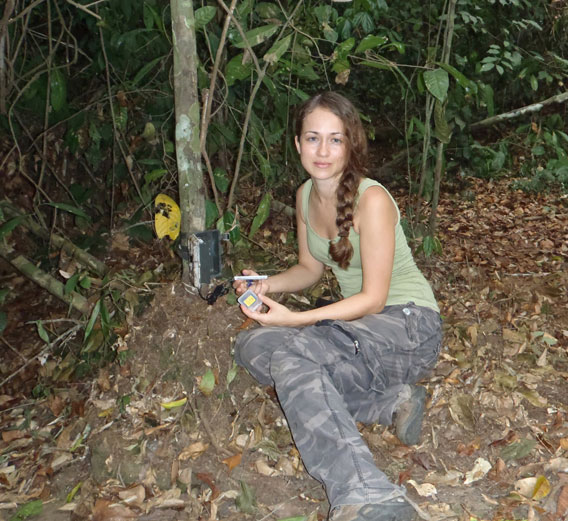
Bahaa-el-din programs a camera trap. Photo courtesy of Laila Bahaa-el-din.
Mongabay: What is your background? How did you become interested in wildlife?
Laila Bahaa-el-din: I don’t remember when my interest in wildlife began, but presume it started as an infant. In fact, I believe most small children have an almost innate interest in animals and nature. This initial interest may wane with age, but it may also persist on its own, or such as in my case, can be cultivated by people around you.
My grandfather, Peter Jackson, is a conservationist and he published several books on tigers, elephants, and cats more generally. He travelled to many parts of the world, and took wonderful pictures which featured in his books. He inspired me from early on and I proudly presented those books to any playmates that would come to call.
I wavered a bit in my teens, with ambitions to be an actress at one point, a barrister at another and finally a vet. But in the end I found myself in the right place: at the University of Nottingham studying zoology for my Bachelor’s degree. I then took part in a Tropical Biology Association (TBA) field course in Kibale National Park in Uganda. On my first day there, I was so enthusiastic and I remember someone saying that he gave me five years before my fire burned out and I was bitter and cynical. That was four years ago, and though I may be less naïve now, I’m certainly not ready to give up.
That course in Uganda marked a sort of beginning to my current life. For the first time I was surrounded by untamed nature: rainforest and all the wildlife that inhabits it. Photography was already a big interest of mine, but how it bloomed in the presence of all that photogenic flora and fauna! From Uganda I travelled onwards to Kenya where I spent perhaps the most inspiring time of my life under the mentorship of raptor expert Simon Thomsett. His enthusiasm for raptors and all wildlife was contagious, and I tried to absorb some of his endless knowledge.
I spent some time volunteering for the Cheetah Conservation Fund (CCF) in Kenya where I learned to radio track collared cheetahs. Then a whole new adventure began on another continent, working at Kipling Camp at the Kanha Tiger Reserve in central India. During my time with CCF, I met Jim Tamarack, who chairs a small fund for conservation projects. He suggested I go to Costa Rica to study the monkeys in the Osa Peninsula, and provided the funds for me to do it, and that was my destination after India. It seems the key was to be open-minded and grab opportunities as they came my way.
AFRICAN GOLDEN CAT
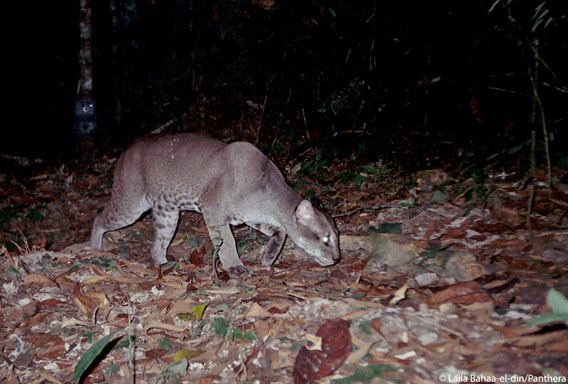
African golden cat in Lopé National Park, Gabon . Photo courtesy of Laila Bahaa-el-din/Panthera.
Mongabay: When did you first hear about the African golden cat?
Laila Bahaa-el-din: Although I enjoyed India and Costa Rica a tremendous amount, I always knew I had to come back to Africa. I worked with Simon Thomsett again on our African Raptor Expedition, and it was during some of our long drives across the continent that he first mentioned the African golden cat. He seemed so intrigued by the species, and that aroused my curiosity.
Mongabay: Will you tell us about this species?
Laila Bahaa-el-din: The African golden cat is a medium-sized cat with a highly variable coat. It may be red or grey and its spots may vary from a few on the inner limbs and lower belly, to all over its body. It is known to feed mostly on mammals, such as rodents and duikers (small antelope). It is a forest-dependent cat and anecdotal reports suggest that African golden cats favor primary forest and abandoned logging areas with dense secondary undergrowth.
The population densities at which they live, the size of their home ranges, and their activity patterns all remain to be established. Though it is often described as nocturnal, my research thus far indicates that golden cats are more cathemeral, meaning they can be active at any time of day or night, depending on circumstances.
Mongabay: You’ve worked with raptors, primates, and cats. What drew you to study this particular species?
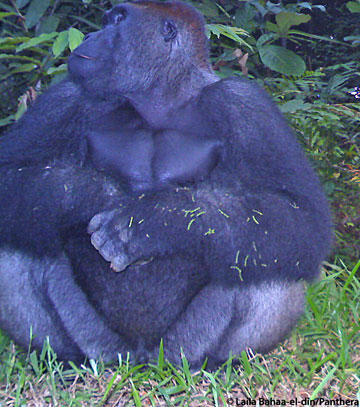 A silverback gorilla sits in front of a camera trap. Photo by: Laila Bahaa-el-din/Panthera. |
Laila Bahaa-el-din: Rather than looking for a particular study species or subject, I had always relied on chance encounters and making contacts to help guide me. I was interested in any project that I thought had conservation value, and any experience that would put me in contact with the natural world.
I had just completed touring eastern and southern Africa on the African Raptor Expedition when luck put me in touch with Dr Philipp Henschel and Dr Luke Hunter of the American NGO Panthera. Henschel hooked me with his first email which included a photo of a golden cat he had taken in Gabon. My ears metaphorically pricked at the mention of Gabon, which had long intrigued me as a country which had maintained a low human population and relatively intact forests. I knew the forests to hold large populations of elephants, gorillas and chimpanzees, along with rarer and more unusual species such as pangolins, bongos and golden cats.
Of course Thomsett had already got me interested in the golden cat, and I couldn’t believe that its ecology had not already been much studied. And here was Henschel offering me the opportunity to study this elusive cat in the very forests I dreamed of exploring. It was too good to be true.
Mongabay: Have you seen a wild African golden cat in person?
Laila Bahaa-el-din: Not yet, but not from lack of trying.
Mongabay: You have captured amazing footage of the African golden cat, deemed the first public footage of the animal in the wild. What was your reaction when you saw the video?
Laila Bahaa-el-din: The African golden cat has dominated my thoughts and energy for over a year and a half now. When carrying out a study like this one, you find yourself trying to think like your study animal. This helps put the camera traps in the right place for example. As I mentioned, I had never seen a golden cat (wild or captive), and still photographs were all I had to go on.
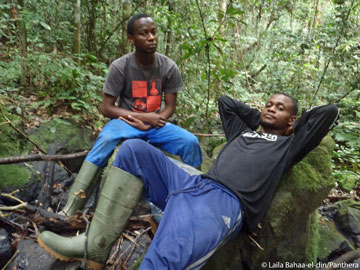 Field assistant Arthur Dibambo and MSc student Endeng N’Solet take a well-deserved rest. Photo by: Laila Bahaa-el-din/Panthera. |
I knew that getting video footage of a golden cat wouldn’t be complicated as I had already had many still images of them from my camera trapping study. But I questioned the value of attempting it as I thought the footage would just consist of a 2-second clip of a golden cat walking past the camera. I wanted natural footage, and so didn’t want to use bait. But on getting back to camp one evening and downloading my latest camera trap images, I found that at one site there was a golden cat being playful with one of the cameras. Much to my field assistant’s dismay, we marched right back to the site to set up the video camera, then left it there for two weeks.
For those two weeks, I was curious to see if the camera had captured the cat, but I knew I had to stay away if I wanted the cat to come back. On finally returning to the site, I found the camera completely destroyed by termites, and my heart sank. We trudged back to camp dejectedly. I recovered the memory card, and uploaded the files to my computer, hoping that perhaps something might have happened before the termites did their worst. And to my amazement, I opened one video file after another featuring a golden cat! I watched them all through once, and then again, and then again. I felt, at last, like I was getting to know this elusive cat.
I was torn between wanting to preserve the mysteriousness of the cat by keeping the footage secret, and wanting to show the world this beautiful cat to raise its profile and keep it from disappearing without anybody taking notice. Of course the latter was the sensible option.
Mongabay: What would you tell students who are interested in studying little-known, cryptic species given that these often have less funding and less baseline science?
Laila Bahaa-el-din: It is difficult to put conservation measures in place for cryptic species whose ecological needs have not yet been identified. Knowing about the animal’s diet, habitat requirements and home range are crucial for making conservation conclusions such as whether current protected areas are sufficient, and if not, where they should be created, and what size they should be to maintain viable populations. I would say this is already a huge incentive to studying cryptic species.
On a personal note, discovering things about your study species for the first time is a huge thrill, and is worth all the trouble of finding the funds and carrying out research on these little-known species.
CAMERA TRAPPING RESEARCH
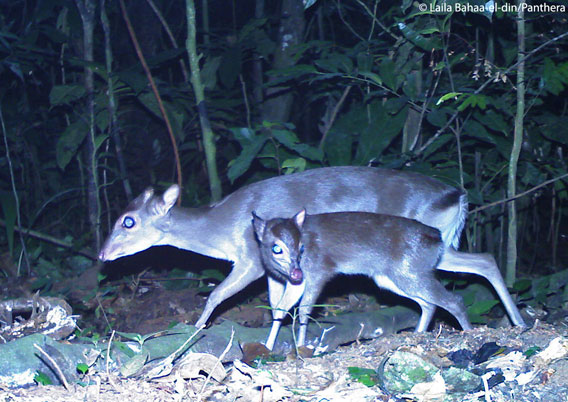
The blue duiker (seen here with a calf) is a common prey species for the golden cat. Photo courtesy of Laila Bahaa-el-din/Panthera.
Mongabay: What are the goals of your camera trap research on the African golden cat?
Laila Bahaa-el-din: The goals include assessing the impacts on golden cats of human activities such as logging and hunting. People may instinctively think that these activities necessarily have negative impacts. To a certain extent, this is true, but they don’t have to be as disastrous as they often are. The range of the golden cat, being restricted to the forests of equatorial Africa, consists of more land within logging concessions than protected areas. It is crucial therefore to understand and reduce how this activity impacts the golden cat.
The video footage I recently captured was actually in a logging concession in central Gabon. It is recognized as having high standards of sustainable logging practices and has a zero tolerance for illegal hunting. At the particular area I had my cameras set up, logging had taken place just two years previously, and active logging was going on just a few kilometers away. As well as the videos, many photos of golden cats were captured, as well as captures of numerous other species such as gorillas, elephants, aardvarks, leopards, duikers, rodents and more.
It indicated that logging alone should not mean the depletion of wildlife. The devastating effects of logging often result from poor management and unsustainable practices. Logging companies open roads into otherwise inaccessible areas, which then allow poachers from outside to hunt within the concessions. With a bit of will, and not much in the way of resources, these roads can be barred and monitored. Logging staff brought into these remote areas can also be a problem, and importantly, over-exploitation of the forests is equally detrimental.
I am now camera trapping at a pristine site with no history of logging or hunting in order to compare the densities of golden cats with the logging concession. I will also be trapping at a less-well managed concession and a site where there is hunting but not logging, thus isolating the impacts of each activity and establishing how best to go about putting together a conservation strategy.
Other goals involve examining the relationship between the golden cat and the leopard, which is known to prey on the golden cat, and compete with it for food. Finally, I’d also like to examine how local communities perceive golden cats and other carnivores, in order to help mitigate conflicts that arise between people and carnivores.
Mongabay: How has the technology of camera trapping aided research efforts of the African golden cat?
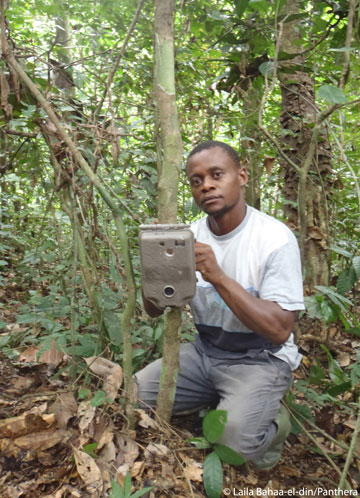 Field assistant Arthur Dibambo sets up a camera trap. Photo by: Laila Bahaa-el-din/Panthera. |
Laila Bahaa-el-din: African golden cats have hitherto been almost impossible to study due to their secretive and shy nature and the difficult forest environment in which they live. Using cameras that are triggered by the movement of passing animals allows us to study wild elusive animals non-invasively. From the data gathered with these camera traps, we can see when the cats are most active, how many live within a certain area and the relative abundance of their prey. Using the cameras at several sites can then allow us to compare all these aspects of golden cat ecology under various conditions. Getting similar data without camera traps would require more invasive methods and would be much more time consuming and expensive.
Mongabay: What types of data can you get from camera traps that you simply can’t get from other methods?
Laila Bahaa-el-din: The pictures that are captured using camera traps allow us to identify individuals through their different spotting patterns. Applying capture-recapture statistics to this data then allows us to estimate the population density of these cats. Previous methods used for applying capture-recapture statistics involved physically trapping the animals, releasing them, and recapturing them. Not only would this be highly invasive to a species such as the golden cat, but it just wouldn’t be logistically possible due to the animal’s timid nature and difficult forest environment.
The camera traps also allow us to see at what times golden cats are most active. They are often described as nocturnal, and this may result from golden cats becoming more active at night in areas with human activity, which would account for people sighting them more regularly at night. Using the camera traps, we can get a large sample of activity times, without the bias of human presence. Equally, camera trapping allows us to gain insight into the habitat preferences of the species.
By comparing these density estimates and activity patterns across a number of sites differing in levels of human activity—such as at a pristine site, in a logging concession, and in a hunting area—we can assess the impacts of these activities on golden cats.
THREATS AND CONSERVATION
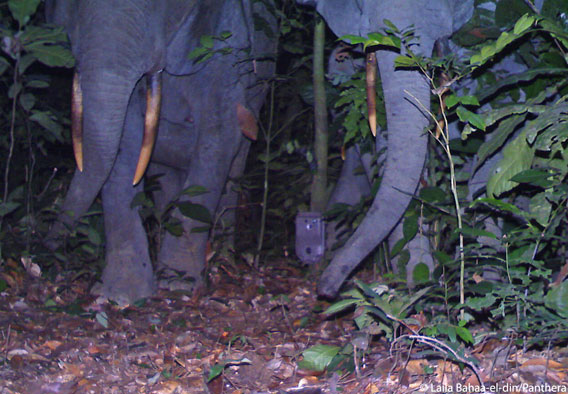
A camera trap sits precariously between two forest elephants. Photo courtesy of Laila Bahaa-el-din/Panthera.
Mongabay: What are the major threats to this species?
Laila Bahaa-el-din: Major threats to the golden cat include commercial logging, depletion of its prey base through bushmeat hunting, direct persecution, and forest clearing for agriculture.
Mongabay: The African golden cat is listed by the IUCN Red List as Near Threatened. From your perspective, how secure is the animal?
Laila Bahaa-el-din: I don’t think we can call any indigenous species secure, particularly those that depend on forests that are worth more (in terms of immediate cash flow) to humans cut down than left standing. Also, across the golden cat’s range, bushmeat is depended on by communities as their only source of protein. This makes the future for golden cats very uncertain. However, there are some areas that offer more hope, such as Gabon where I am currently working. The human population here is low, 13 national parks have recently been created, and the government is keen to promote a “Green Gabon”.
Mongabay: Given that the world’s big popular cats are also endangered (tigers, lions, jaguars, cheetahs, etc.) what case would you make for spending energy on the many lesser-known wild cats in the world?
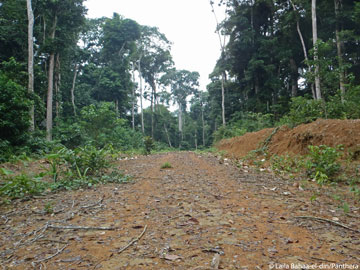 Logging roads provide access to otherwise inaccessible areas. Photo by: Laila Bahaa-el-din/Panthera. |
Laila Bahaa-el-din: Given that all the big cat species you mention are listed on the IUCN Red List of Threatened Species, they are entirely in need of the attention and funding that they get. But studying the lesser-known cats does not detract from the great work being done to conserve these bigger cats.
An animal being “popular” or aesthetically pleasing does not make it more important in terms of its conservation. This is clearly shown by the important role of, for example, some insect species in their ecosystems. While an argument for conserving the big cats is that they are keystone species and protecting them means preserving whole ecosystems, the same can said for lesser-known species. The African golden cat, for example, is the only cat that is entirely dependent on Africa’s tropical forests and putting measures in place targeted at insuring a future for this species would necessarily involve the conservation of the forests it inhabits and the species it preys on.
Mongabay: You’ve had a lot of success in your career so far. Any recommendations you would give students interested in pursuing conservation research?
Laila Bahaa-el-din: I wouldn’t call it so much success as having had some incredible experiences. It has been and continues to be a learning curve. My main advice would be not to get discouraged, and seize opportunities when they arise. Don’t be afraid to approach people and put yourself forward. And most importantly, don’t let people convince you that it’s hopeless. Like others before you, you can be responsible for the conservation of a species, or the protection of a piece of land. Through your findings, you can influence decisions at the highest levels. If enough of us continue to fight for a world in which wilderness and wildlife have a place, it will happen.
Mongabay: Any future plans you’d like to share with us?
Laila Bahaa-el-din: The next couple of years will be taken up by my studies on the golden cat. With the information gathered during this study, I then hope, with the help of Panthera, to establish a conservation strategy for the species. Conserving the golden cat is of course a goal in itself, but through the protection of a sensitive predator such as this one, you also conserve its habitat and prey species. As such, the African golden cat can act as a flagship species for the protection of Africa’s tropical forests.
An African golden cat sits directly in front of Panthera’s camera.
A playful African golden cat hunting a bat at night.
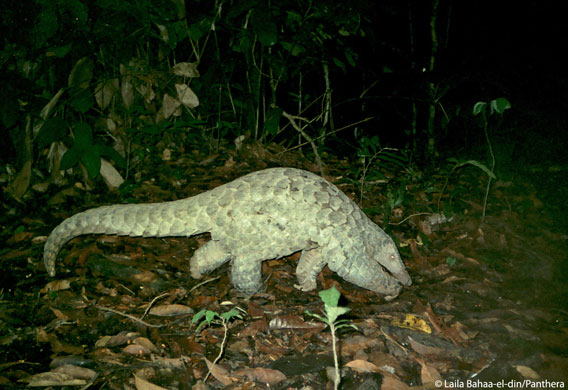
A giant pangolin caught on camera trap. Photo by: Laila Bahaa-el-din/Panthera.
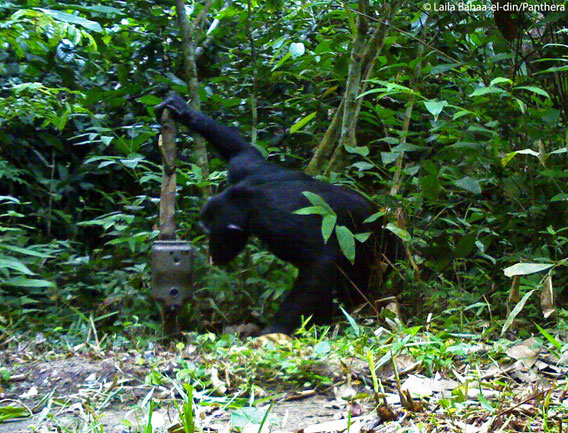
A chimpanzee checks out a camera trap. Photo by: Laila Bahaa-el-din/Panthera.
Related articles
One of world’s rarest cats caught on video for the first time
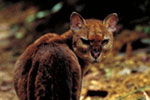
(08/30/2011) Africa is known as a continent of felines: leopards, cheetahs, servals, caracals, and of course the one who wears the crown, the lion. But, few people travel to Africa to see, or have probably ever heard of, the African golden cat. Native to the rainforests of central Africa (from Kenya to Cameroon) with a separate population in West Africa, the African golden cat (Caracal aurata) is considered the continent’s least-studied feline. However, a team of researchers is hoping to change this: using camera traps scientists have taken the first ever public video of the African golden cat.
Leopards losing out to bushmeat hunters in competition for prey
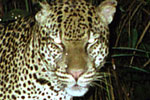
(08/25/2011) According to a surprising new study in the Journal of Zoology, bushmeat hunting is imperiling jungle-dwelling leopards (Panthera pardus) in Africa, even though hunters aren’t targeting the elusive big cats themselves. Instead, by hunting many of the leopard’s preferred prey—such as red river hogs and forest antelopes—bushmeat hunters are out-competing leopards.
Cameratraps take global snapshot of declining tropical mammals
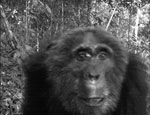
(08/17/2011) A groundbreaking cameratrap study has mapped the abundance, or lack thereof, of tropical mammal populations across seven countries in some of the world’s most important rainforests. Undertaken by The Tropical Ecology Assessment and Monitoring Network (TEAM), the study found that habitat loss was having a critical impact on mammals. The study, which documented 105 mammals (nearly 2 percent of the world’s known mammals) on three continents, also confirmed that mammals fared far better—both in diversity and abundance—in areas with continuous forest versus areas that had been degraded.